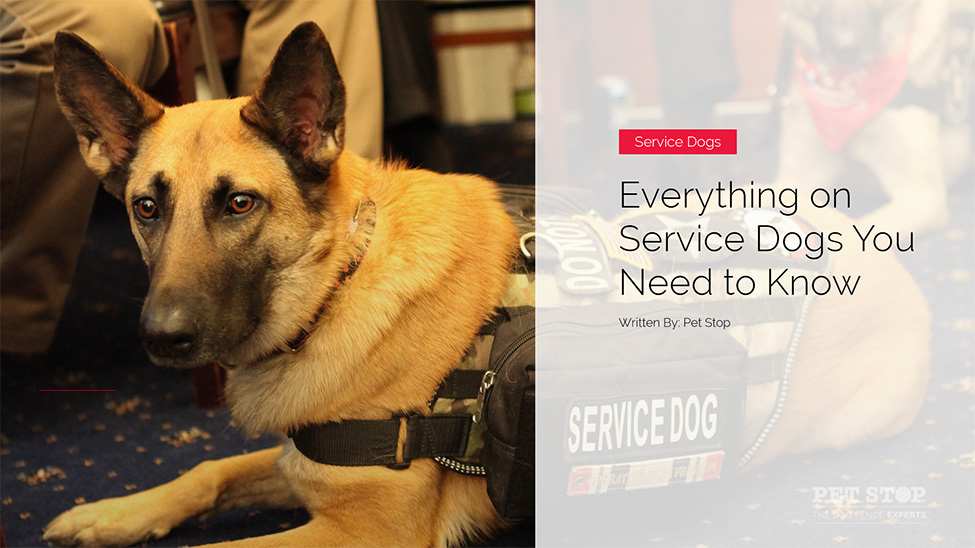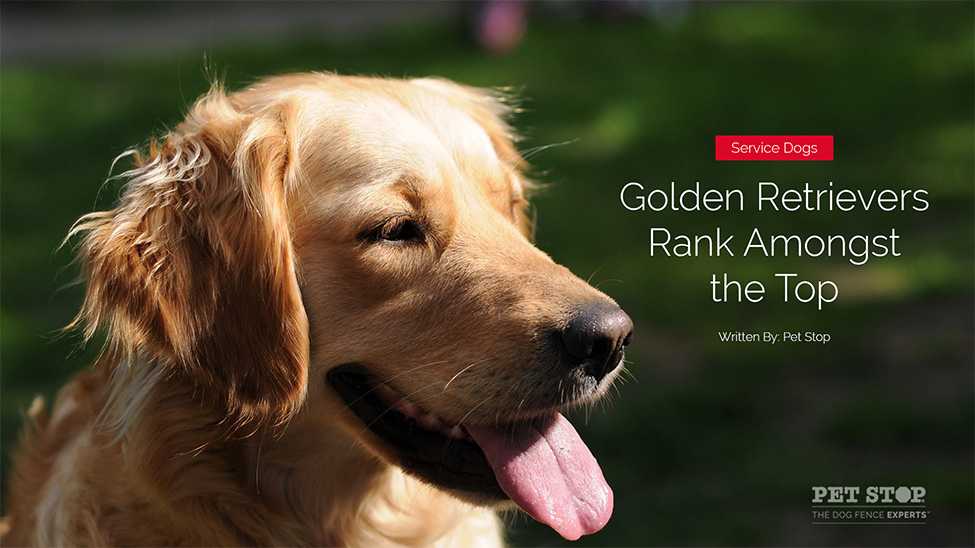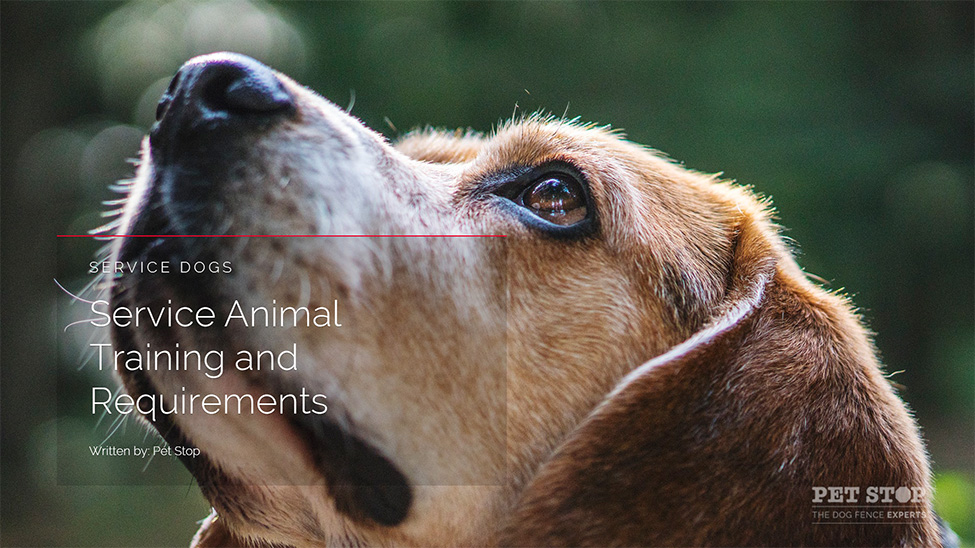Everything you
Need to Know
About Service
Animals
For decades, dogs have been a loyal companion to humans. They’ve been at our side and have been integral parts of our culture, helping us with many things including hunting, protection and the management of small critters in our towns. As our human relationships with dogs have developed, so have their utility and skillsets for us as humans.
In this article we’ll discuss a service animals in detail from what they are, how they help, which breeds of dogs are most commonly chosen and why, assessing, training and service animal certification.
All across the country, people with disabilities are able to live more normal lives as a result of a service animal. In the United States alone, there’s around 200,000 service dogs alone. Service animals can help improve the quality of life of people suffering from various types of debilitating conditions such as:
- Depression
- Panic Attacks
- Anxiety
- Deafness
- Blindness
- PTSD
- Autism
- Epilepsy
- Life-Threatening Allergies
- Other Psychiatric Disabilities
One thing to note is that not all therapy dogs are service dogs. Service dogs are different from emotional support dogs. The reason is because service animals need to undergo rigorous training in order to successfully complete certain tasks for people with disabilities. On the other hand, emotional support animals don’t need to complete or perform specific tasks, they just need to be present to provide the emotional support, stability and love required to help comfort their owner.
Let’s explore some of the various aspects of a service dog.
Definition: Simply put, a service animal is any dog that is individually trained to do work or perform tasks for the benefit of an individual with a disability including a physical, sensory, psychiatric, intellectual or other mental disability.
The key with service animals is that that the tasks or work done by the service animal must be directly correlated to the individual’s disability. Here are some examples of work or tasks, but are not limited to:
- Helping people who are blind or have poor vision.
- Providing support and alerting people who are hard of hearing or deaf to people or sounds
- Service dogs can provide protection or rescue work
- Pulling a wheelchair for those who are unable to walk
- Service dogs can also be trained to assist people during a seizure
- Alerting people to the presence of allergens
- Retrieving basic items around the house such as medicine or telephones
- For those who have mobility issues, service dogs can provide balance and stability
- Service dogs can help interrupt impulsive or destructive behaviors
Now in order to have a service animal, it’s important that you fully understand the ADA or Americans with Disabilities Act so you’re aware of the regulations and laws surround having one.
The ADA states that Service Animals are working animals, not pets. The purpose of having a service animal is that they’ve gone under special training to provide service to someone with a disability. Dogs whose sole function is to provide comfort or emotional support do not qualify as service animals.
Now that we have a better understanding of what service animal is, let’s dive into the most popular breeds of dogs that serve as service animals.
Best Service Dog Breeds
While almost any breed of dog can be a service animal if trained properly, there are a few outperform other breeds in terms of trainability and overall performance when it comes to being a service animal.
Here are the top 6:
Golden Retrievers
Perhaps the most well known service animals are Golden Retrievers. You’ll often seem them with those who are hard of hearing or have poor sight. Their kind and gentle temperament make them wonderful service dogs. They’re also friendly towards children. They help provide good emotional support and are helpful in providing support to people with autism as well.
German Shepherd
German Shepherds are the pinnacle of service dogs. You’ll find them serving almost every institution including police, military and fire teams during search and rescue. They’re suited well as being guide dogs and they provide great balance as a service dog overall because of their size, strength and trainability.
Collie
As dogs, Collie’s are highly intelligent, loyal and friendly. They’ve been shown to help detect seizures in advance. Their most popular purpose serves in their ability to assist with seizures. They’ve been known to be called seizure alert dogs. In addition, they’ve been helpful in providing emotional support for people with anxiety and PTSD.
Bernese Mountain Dog
These loving gentle giants are great service animals because they can help with a variety of different tasks including mobile support for people in wheelchairs, retrieving medications and opening the door for emergencies. They have a great temperament and have a good intellect which makes them trainable and obedient. These dogs can make life much easier for those who are requiring a service pet to provide mobility and emergency tasks.
Poodle
While you may not associate Poodles as a service dog, they have the skills and ability to help detect food allergens through their extreme sense of smell. For people with life threatening allergies, a poodle service dog can be a lifesaver. They can also help people with mobility issues by helping them pick up dropped items, opening doors and turning lights on and off.
Pomeranian
Yes, even these cute little fuzz balls can be service pets! Pomeranians are known to be great medical alert dogs. They can help you detect if you are diabetic, hypoglycemic, having an asthma attack or a heart attack just to name a few.
People who have hearing issues will especially appreciate pomeranian’s as they have been known to be great hearing dogs. They can help with things like knocks at the door or a ringing phone. They help people with hearing issues know when to pay attention.
Service Animal Training
Training a service dog requires a variety of steps and can be a long and difficult process. However, don’t be discouraged, with enough commitment, time, training and the right trainer, you too can certify your dog to become registered as a service animal.
In order to become a service animal, dogs must perform a variety of tasks and commands that are need for the Assistance Dogs International Public Access Test, a series of objectives designed to evaluate the dog’s behavior in distracting environments. These organizations have very high standards and the dropout rate for organization trained service dogs can be as a high as 50-70 percent!
If you’re looking to train your dog on your own, it’s wise to seek out a professional trainer that can help. A good place to look and consult with would be the ADI or Assistance Dogs International. They can help you find a reputable and authentic trainer who is familiar with the various laws and training methods required for service dogs.
And again remember, that service dogs must be trained in specific skills pertaining to the handler’s disability in public access skills. They must be house trained and well trained in public.
There are a variety of skills that can be taught to dogs who are training to become a service animal. Here are a list of them by category and skillset.
Alert
- Service animals will be trained to alert their owner about specific smells
- People approaching
- Sounds like alarms, ringtones, sirens or vehicles backing up
- Pressing medical alert buttons
- Wake up alerts
- Responses to someone getting your attention or calling your name
Calm
- Provide support
- Cuddle on cue
- Interrupt behaviors that are repetitive or compulsive
- Lead or uncrowded areas to sit down
- Help respond to anxiety attacks or panic attacks
- Interrupt nightmares or night terrors
Detect
- Service pets can be trained to detect allergens such as specific foods or odors
- Low blood sugar levels
- Change in cortisol levels
Retrieve
- They can be trained to bring you personal items like, keys, wallet and phones
- Carry items for you
- Open and close doors, cabinets, drawers, appliances etc
- Bring medication to you at designated times
- Help pay for items at a cash register
Support
- Act as a positional buff around people
- Provide bracing and mobility support
- Assist with dressing
- Offer signals that allows you to excuse yourself
Pretty amazing stuff! As you can see, service animals can help perform just about any daily task that someone might need to support their quality of life and standard of independence.
So now that you have an idea of how skilled and trained these service dogs can be, you might ask yourself “Just how much does it cost to train a service dog to become this skilled?”
How Much Does Service Dog Training Cost?
As you might imagine, service dogs aren’t cheap. Their training can cost an upwards of $25,000 and can take up to two years. Typically organizations will charge fees ranging within a few thousand dollars of this and it doesn’t include the additional expenses such as food and veterinary care. What’s important to note is that some of these organizations may offer financial aid for those who cannot afford it, but need the aid. It’s also recommended that the owner work with a professional trainer for the life of the dog to ensure working reliability.
Assessing Your Dog – is Your Dog Qualified to be a Service Dog?
In order to qualify and become a service dog, your dog must have a special set of qualities. These characteristics include:
- Calm but Friendly
- Alert but not reactive
- Able to be touched by anyone, including strangers
- Willingness to please
- Tendency to follow you around
- Socialized in many different situations and environments
- Ability to learn quickly and retain information
Not every dog can become a service dog, it requires a specific set of qualities, temperament and intellect. Speak to a professional service dog organization or trainer and set up a consultation to determine whether your dog has the potential to become a service animal.
Service Animal Assessment and Testing
There are a variety of assessments and tests required by the ADA that your dog should pass in order to qualify it as a service pet. Here are a few for “On-Leash” service dogs:
- Commands
- Controlled Unload out of a Vehicle
- Approaching a building
- Controlled Entry Through a Doorway
- Helping through a building
- Heeling through a building
- Six foot recall on lead
- Sits on Command
- Downs on Command
- Noise Distraction
- Restaurant Manners
- Off Lead
- Controlled Unit
The definitions of each of these assessments can be found here.
How to Register your Dog as a Service Animal
Because service dog registration is self-regulated in the United States, you just need to find a reputable service like The United States Service Dog Registry and register your dog. They will help ensure canine competency and any future situation where your dog or you might be questioned. Always ensure that you choose a proven and backed service when registering your service animal to prevent any legal issues down the line.
Resources:
http://dogsaholic.com/training/make-your-dog-a-service-dog.html
https://www.esaregistration.org/faq/
https://pets.thenest.com/pet-certified-service-animal-8325.html
 Pet Stop
Pet Stop Get a Free Quote
Connect with Your Local Pet Safety Experts at Pet Stop. Visit, call, or
chat with us – we’re here to help you create the ultimate safe haven for your pet.
Get a Free quote
Name *
Zip code where new fence is required *
Preferred contact method *
Phone Number to Call/Text *
Address *
Stay Connected, Stay in Control
Brief introduction to the OT-300, highlighting remote control, real-time notifications, and easy setup through the Pet Stop Link App.
Download the App


